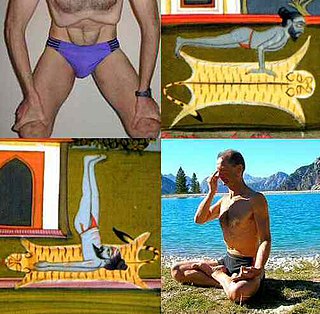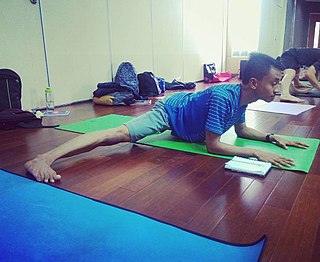Related Research Articles

Meditation is a practice in which an individual uses a technique – such as mindfulness, or focusing the mind on a particular object, thought, or activity – to train attention and awareness, and achieve a mentally clear and emotionally calm and stable state.
In yoga, Ayurveda, and Indian martial arts, prana permeates reality on all levels including inanimate objects. In Hindu literature, prāṇa is sometimes described as originating from the Sun and connecting the elements.

Hatha yoga is a branch of yoga that uses physical techniques to try to preserve and channel vital force or energy. The Sanskrit word हठ haṭha literally means "force", alluding to a system of physical techniques. Some hatha yoga style techniques can be traced back at least to the 1st-century CE, in texts such as the Hindu Sanskrit epics and Buddhism's Pali canon. The oldest dated text so far found to describe hatha yoga, the 11th-century Amṛtasiddhi, comes from a tantric Buddhist milieu. The oldest texts to use the terminology of hatha are also Vajrayana Buddhist. Hindu hatha yoga texts appear from the 11th century onward.
The Buteyko method or Buteyko Breathing Technique is a form of complementary or alternative physical therapy that proposes the use of breathing exercises primarily as a treatment for asthma and other respiratory conditions.

Stanislav "Stan" Grof is an American psychiatrist. Grof is one of the principal developers of transpersonal psychology and research into the use of non-ordinary states of consciousness for purposes of psychological healing, deep self-exploration, and obtaining growth and insights into the human psyche.

Pranayama is the yogic practice of focusing on breath. In yoga, breath is associated with prana, thus, pranayama is a means to elevate the prana-shakti, or life energies. Pranayama is described in Hindu texts such as the Bhagavad Gita and the Yoga Sutras of Patanjali. Later in Hatha yoga texts, it meant the complete suspension of breathing. The pranayama practices in modern yoga as exercise are unlike those of the Hatha yoga tradition.

Yoga nidra or yogic sleep in modern usage is a state of consciousness between waking and sleeping, typically induced by a guided meditation.
Mindfulness is the cognitive skill, usually developed through meditation, of sustaining meta-attention of the contents of one's own mind in the present moment. Mindfulness derives from sati, a significant element of Hindu and Buddhist traditions, and is based on Zen, Vipassanā, and Tibetan meditation techniques. Though definitions and techniques of mindfulness are wide-ranging, Buddhist traditions describe what constitutes mindfulness, such as how perceptions of the past, present and future arise and cease as momentary sense-impressions and mental phenomena. Individuals who have contributed to the popularity of mindfulness in the modern Western context include Thích Nhất Hạnh, Joseph Goldstein, Herbert Benson, Jon Kabat-Zinn, and Richard J. Davidson.

Breathwork is a term for various breathing practices in which the conscious control of breathing is said to influence a person's mental, emotional, or physical state, with a therapeutic effect.

Yoga as therapy is the use of yoga as exercise, consisting mainly of postures called asanas, as a gentle form of exercise and relaxation applied specifically with the intention of improving health. This form of yoga is widely practised in classes, and may involve meditation, imagery, breath work (pranayama) and calming music as well as postural yoga.

The psychological and physiological effects of meditation have been studied. In recent years, studies of meditation have increasingly involved the use of modern instruments, such as fMRI and EEG, which are able to observe brain physiology and neural activity in living subjects, either during the act of meditation itself or before and after meditation. Correlations can thus be established between meditative practices and brain structure or function.
Dennis Lewis is a non-fiction writer and teacher in the areas of breathing, qigong, meditation, and self-enquiry.

Breathing is the rhythmical process of moving air into and out of the lungs to facilitate gas exchange with the internal environment, mostly to flush out carbon dioxide and bring in oxygen.

In psychology, relaxation is the emotional state of low tension, in which there is an absence of arousal, particularly from negative sources such as anger, anxiety, or fear.
Mindfulness-based stress reduction (MBSR) is an eight-week evidence-based program that offers secular, intensive mindfulness training to assist people with stress, anxiety, depression and pain. Developed at the University of Massachusetts Medical Center in the 1970s by Professor Jon Kabat-Zinn, MBSR uses a combination of mindfulness meditation, body awareness, yoga and exploration of patterns of behavior, thinking, feeling and action. Mindfulness can be understood as the non-judgmental acceptance and investigation of present experience, including body sensations, internal mental states, thoughts, emotions, impulses and memories, in order to reduce suffering or distress and to increase well-being. Mindfulness meditation is a method by which attention skills are cultivated, emotional regulation is developed, and rumination and worry are significantly reduced. During the past decades, mindfulness meditation has been the subject of more controlled clinical research, which suggests its potential beneficial effects for mental health, athletic performance, as well as physical health. While MBSR has its roots in wisdom teachings of Zen Buddhism, Hatha Yoga, Vipassana and Advaita Vedanta, the program itself is secular. The MBSR program is described in detail in Kabat-Zinn's 1990 book Full Catastrophe Living.
Trauma-sensitive yoga is yoga as exercise, adapted from 2002 onwards for work with individuals affected by psychological trauma. Its goal is to help trauma survivors to develop a greater sense of mind-body connection, to ease their physiological experiences of trauma, to gain a greater sense of ownership over their bodies, and to augment their overall well-being. However, a 2019 systematic review found that the studies to date were not sufficiently robustly designed to provide strong evidence of yoga's effectiveness as a therapy; it called for further research.

Mindful Yoga or Mindfulness Yoga combines Buddhist-style mindfulness practice with yoga as exercise to provide a means of exercise that is also meditative and useful for reducing stress. Buddhism and Hinduism have since ancient times shared many aspects of philosophy and practice including mindfulness, understanding the suffering caused by an erroneous view of reality, and using concentrated and meditative states to address such suffering.

The science of yoga is the scientific basis of modern yoga as physical exercise in human sciences such as anatomy, physiology, and psychology. Yoga's effects are to some extent shared with other forms of exercise, though it differs in the amount of stretching involved, and because of its frequent use of long holds and relaxation, in its ability to reduce stress. Yoga is here treated separately from meditation, which has effects of its own, though yoga and meditation are combined in some schools of yoga.
Mindfulness-based pain management (MBPM) is a mindfulness-based intervention (MBI) providing specific applications for people living with chronic pain and illness. Adapting the core concepts and practices of mindfulness-based stress reduction (MBSR) and mindfulness-based cognitive therapy (MBCT), MBPM includes a distinctive emphasis on the practice of 'loving-kindness', and has been seen as sensitive to concerns about removing mindfulness teaching from its original ethical framework. It was developed by Vidyamala Burch and is delivered through the programs of Breathworks. It has been subject to a range of clinical studies demonstrating its effectiveness.
Breathwork may refer to several different practices connected with breathing.
References
- 1 2 3 Swami Saradananda (2009). The Power of Breath: The Art of Breathing Well for Harmony, Happiness, and Health. Watkins Media. ISBN 978-1-84483-798-4.
- ↑ "The Effects of Reverse Breathing". LIVESTRONG.COM. Retrieved 2019-02-24.[ unreliable source? ]
- ↑ Lewis, D. (2006). The Tao of Natural Breathing: For Health, Well-Being, and Inner Growth. Shambhala. ISBN 978-1930485143.
- ↑ Hart, William (1987). The art of living : Vipassana meditation as taught by S.N. Goenka (1st ed.). San Francisco: Harper & Row. ISBN 978-1-928706-73-1. OCLC 778448192.
- ↑ "What is Circular Breathing? (with pictures)". Musical Expert. Retrieved Aug 27, 2022.
- ↑ Sundberg, Johan (January–February 1993). "Breathing behavior during singing" (PDF). The NATS Journal. 49: 2–9, 49–51. ISSN 0884-8106. OCLC 16072337. Archived (PDF) from the original on 29 May 2019.
- 1 2 Baggoley C (2015). "Review of the Australian Government Rebate on Natural Therapies for Private Health Insurance" (PDF). Australian Government – Department of Health. Archived from the original (PDF) on 26 June 2016. Retrieved 12 December 2015.
- ↑ Scottish Intercollegiate Guidelines Network (2014). "British guideline on the management of asthma". Thorax (Practice guideline). 69 (Suppl 1): 1–192. PMID 25323740.
- ↑ Ehrmann, Wilfried (2004). Handbuch der Atemtherapie. Ahlerstedt. ISBN 978-3-88755-050-9. OCLC 238421972.
{{cite book}}: CS1 maint: location missing publisher (link) - ↑ Platteel-Deur, Tilke (2014). The Art of Integrative Therapy Healing the Past on a Soul Level. München. ISBN 978-3-7368-1993-1. OCLC 946133875.
{{cite book}}: CS1 maint: location missing publisher (link) - ↑ Brewerton, Timothy D.; Eyerman, James E.; Cappetta, Pamela; Mithoefer, Michael C. (2011). "Long-Term Abstinence Following Holotropic Breathwork as Adjunctive Treatment of Substance Use Disorders and Related Psychiatric Comorbidity". International Journal of Mental Health and Addiction. 10 (3): 453–459. doi:10.1007/s11469-011-9352-3. S2CID 32003053.
- ↑ Descilo, T; Vedamurtachar, A; Gerbarg, PL; Nagaraja, D; Gangadhar, BN; Damodaran, B; Adelson, B; Braslow, LH; Marcus, S; Brown, RP (2010). "Effects of a yoga breath intervention alone and in combination with an exposure therapy for post-traumatic stress disorder and depression in survivors of the 2004 South-East Asia tsunami". Acta Psychiatr Scand . 121 (4): 289–300. doi:10.1111/j.1600-0447.2009.01466.x. PMID 19694633. S2CID 6209543.
- ↑ McClernon, F.Joseph; Westman, Eric C.; Rose, Jed E. (2004-06-01). "The effects of controlled deep breathing on smoking withdrawal symptoms in dependent smokers". Addictive Behaviors. 29 (4): 765–772. doi:10.1016/j.addbeh.2004.02.005. ISSN 0306-4603. PMID 15135559.
- ↑ Ehrmann, Wilfried (2017). Coherent Breathing Aligning Breath and Heart. tao.de. Bielefeld. ISBN 978-3-96051-539-5. OCLC 974494732.
{{cite book}}: CS1 maint: location missing publisher (link) - ↑ Fincham, G. W.; Strauss, C.; Cavanagh, K. (2023). "Effect of coherent breathing on mental health and wellbeing: a randomised placebo-controlled trial". Scientific Reports. 13 (1): 22141. Bibcode:2023NatSR..1322141F. doi:10.1038/s41598-023-49279-8. PMC 10719279 . PMID 38092805.
- ↑ Grof, Stanislav (2010). Holotropic breathwork : a new approach to self-exploration and therapy. Christina Grof. Albany: State University of New York Press. ISBN 978-1-4416-6961-2. OCLC 658062355.
- ↑ Orr, Leonard (2007). Rebirthing in the new age. Sondra Ray (3rd ed.). Victoria, B.C.: Trafford. ISBN 978-1-4251-1416-9. OCLC 191934795.
- ↑ "Can you breathe your way to health, happiness and a psychedelic trip?". The Guardian. Retrieved 2024-04-27.
- ↑ "Breathing to inspire and arouse". Science. Retrieved 2024-04-27.
- ↑ Jerath, Ravinder; Edry, John W.; Barnes, Vernon A.; Jerath, Vandna (2006). "Physiology of long pranayamic breathing: Neural respiratory elements may provide a mechanism that explains how slow deep breathing shifts the autonomic nervous system". Medical Hypothesis. 67 (3): 566–567. doi:10.1016/j.mehy.2006.02.042. PMID 16624497 . Retrieved 2024-04-27.
- ↑ "Mindfulness and breathing techniques for exam stress".